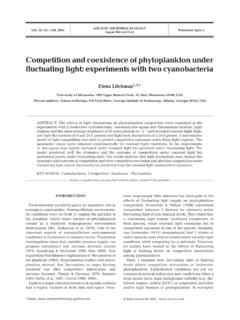Transcription of DARK ACTIVATED COLOUR CHANGING NIGHT …
1 dark ACTIVATED COLOUR CHANGING NIGHT light KIT CREATE SOOTHING LIGHTING EFFECTS WITH THIS ESSENTIAL INFORMATIONBUILD INSTRUCTIONSCHECKING YOUR PCB & FAULT-FINDINGMECHANICAL DETAILSHOW THE KIT WORKSV ersion dark ACTIVATED NIGHT light Essentials Build Instructions Before you start, take a look at the Printed Circuit Board (PCB). The components go in the side with the writing on and the solder goes on the side with the tracks and silver pads. Start with the 220 resistor, which has red, red, brown coloured bands. Solder this resistor into the board where it is labelled R4. Place the two transistors into the board where it is labelled Q1 and Q2. It is important that they are inserted in the correct orientation.
2 Ensure that the shape of the device matches the outline printed on the PCB. Once you are happy, solder the devices into place. Solder the variable resistor into R1. It will only fit in the holes in the board when it is the correct way around. Solder the LDR in to the circle indicated by the text R2. This is next to the dark text. It does not matter which way around it is inserted. The COLOUR CHANGING LED used in this kit doesn t need a current limit resistor as it is a 5V LED. Therefore we need to add a wire link. Take a piece of wire (the lead you have just cut off the LDR is perfect) and solder it into the board where it is marked R3. Solder the light Emitting Diode into LED1. The LED won t work if it doesn t go in the right way around.
3 If you look carefully one side of the LED has a flat edge, which must line up with the flat edge on the lines on the PCB. Now you must attach the battery clip. It needs to be connected to the terminals marked Power . The red lead should be soldered to the + terminal also marked red and the black lead should be soldered to the - terminal also marked black . PLACE THE RESISTOR 1 PLACE THE TRANSISTORS 2 SOLDER THE VARIABLE RESISTOR 3 SOLDER THE LDR 4 ADD A WIRE LINK 5 SOLDER THE LED 6 ATTACH THE BATTERY CLIP 7 dark ACTIVATED NIGHT light Essentials Checking Your NIGHT light PCB Check the following before you connect power to the board: Check the bottom of the board to ensure that: All these leads are soldered.
4 Pins next to each other are not soldered together. Check the top of the board to ensure that: The body of the two transistors matches the outline on the PCB. The flat edge on the LED lines matches the outline on the PCB. The power clip is attached where it is marked Power . The red wire on the power clip goes to the connection marked red and the black wire to the connection marked black . Testing the PCB You might need to adjust the variable resistor R1. It won t be far wrong if you start with the resistor pointing at the middle of the text components . When the sensor is covered (so that it is dark ) the LED should be on. When the sensor is light the LED should be off.
5 If this is not the case, recheck your board following the instructions at the top of this page. dark ACTIVATED NIGHT light Essentials Fault Finding StartCan you get the LED to light by covering the LDRand adjusting the variableresistor?YesNoCheck There is a wire link in R3 and it does not have dry joints. There is a resistor in R1 and R4 and that they do not have dry joints. The LDR is in R2 and does not have dry joints or is shorted. The LED is in the right way around and does not have dry joints or shorted legs. The base and collector pins on the transistors do not have dry joints. The power is connected the correct way finding flow chartDoes the LED have the required brightness or is it dim?
6 No the LED is dimCheck The emitter pins on the transistors do not have dry joints. The transistors are the correct way around. The resistor is in R4 and the wire link is in you adjust the variable resistor so thatthe LED turns of when you un-cover the LDR?YesNo the LED is always onCheck The base and emitter on both transistors for shorts. The single pin of the variable resistor is shorted to the empty pad next to it. The power connector is connected to the power inputs and not the output the circuit seemoverly sensitive to changes in light / dark ?NoYesCheck The base and collector pins on the either of the transistors are not shorted. The transistors are inserted in the correct way ACTIVATED NIGHT light Essentials Designing the Enclosure When you design the enclosure, you will need to consider: The size of the PCB (below left).
7 How big the batteries are (right). These technical drawings of the PCB and battery holder should help you to plan this. All dimensions in mm x4 holes diameter Mounting the PCB to the enclosure The drawing to the left shows how a hex spacer can be used with two bolts to fix the PCB to the enclosure. Your PCB has four mounting holes designed to take M3 bolts. dark ACTIVATED NIGHT light Essentials How the dark ACTIVATED Switch Works The circuit operation is very simple. When the input to the transistor Q1, which is fed from the connecting point of R1 and R2, is greater than the output (LED), is turned on. The voltage at the join of R1 and R2 is determined by the ratio of the two resistors.
8 This is known as potential divider. Voltage at joint of R1 and R2 = the supply Voltage x 212 RRR+ Normally it requires to turn on a transistor but this circuit uses two transistors in a Darlington Pair, meaning that it requires 2 x = to turn on both transistors. It is also worth noting that the output, when turned on, will be around lower than the supply voltage V+. This is because of the voltage drop across the collector and emitter pins of the Darlington Pair of transistors. Therefore if the supply voltage is 5V, then the output voltage will be around R4 is present to protect the transistor should the variable resistor be set to zero. Adjusting the trigger level The point at which the circuit is triggered is set by the 100K variable resistor.
9 By varying the value of this resistor, the ratio of the resistance of R1 and R2 can be varied to a point where a centre voltage (trip point) of is achieved at the desired light level. LED When the board switches on the output, the LED will turn on. With a normal LED you would need a resistor to limit the current flowing into the LED to ensure that it isn t damaged and to control the brightness. This would be resistor R3. With the COLOUR CHANGING LED, this is built into the LED itself. This is why when you built the kit, R3 has been replaced with a simple wire link. Batteryx4 AALED1R4220 Transistor Q2 Transistor Q1R1100KR2 Online Information Two sets of information can be downloaded from the product page where the kit can also be reordered from.
10 The Essential Information contains all of the information that you need to get started with the kit and the Teaching Resources contains more information on soldering, components used in the kit, educational schemes of work and so on and also includes the essentials. Download from: Every effort has been made to ensure that these notes are correct, however Kitronik accept no responsibility for issues arising from errors / omissions in the notes. Kitronik Ltd - Any unauthorised copying / duplication of this booklet or part thereof for purposes except for use with Kitronik project kits is not allowed without Kitronik s prior consent. This kit is designed and manufactured in the UK by Kitronik








